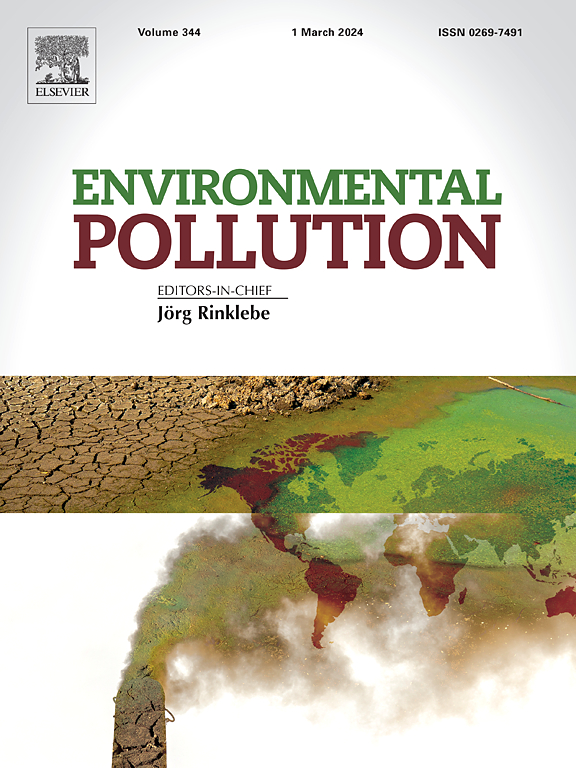Toxicological effects and molecular metabolic of polystyrene nanoplastics on soybean (Glycine max L.): Strengthening defense ability by enhancing secondary metabolisms
IF 7.3
2区 环境科学与生态学
Q1 ENVIRONMENTAL SCIENCES
引用次数: 0
Abstract
Nanoplastics, as emerging pollutants, have attracted worldwide concern for their possible environmental dangers. The ingestion and accumulation of nanoplastics in crops can contaminate the food chain and have unintended consequences for human health. In this study, we revealed the effects of polystyrene nanoplastics (PS-NPs; 80 nm) at different concentrations (0, 10, 100 mg L−1) on soybean (Glycine max L.) seedling growth, antioxidant enzyme system and secondary metabolism. Using laser confocal microscopy, we demonstrated that the absorption and translocation of PS-NPs in soybean. Plant growth inhibition was observed by changes in plant height, root length, and leaf area after 7 days of exposure to PS-NPs. The effect of PS-NPs on photosynthetic characteristics was reflected by a significant reduction in total chlorophyll content at 10 mg L−1. Activation of the antioxidant system was observed with increased malondialdehyde (MDA) content, and elevated activities of superoxide dismutase (SOD) and catalase (CAT). Non-targeted metabolomics analysis identified a total of 159 secondary metabolites, and exposure to 10 and 100 mg L−1 PS-NPs resulted in the production of 61 and 62 differential secondary metabolites. Metabolomics analysis showed that PS-NPs treatment altered the secondary metabolic profile of soybean leaves through the biosynthesis pathways of flavonoid, flavone flavonol, and isoflavones, which is expected to provide new insights into the tolerance mechanisms of plants to nanoplastics. Overall, the results of this study deepen our understanding of the negative impacts of nanoplastics in agricultural systems, which is crucial for assessing the risks of nanoplastics to ecological security.


聚苯乙烯纳米塑料对大豆(Glycine max L.)的毒理学效应和分子代谢:通过增强次级代谢来增强防御能力
纳米塑料作为一种新兴的污染物,其可能造成的环境危害引起了世界各国的关注。作物中纳米塑料的摄入和积累会污染食物链,并对人类健康产生意想不到的后果。在本研究中,我们揭示了聚苯乙烯纳米塑料(PS-NPs;不同浓度(0、10、100 mg L-1)对大豆(Glycine max L.)幼苗生长、抗氧化酶系统和次生代谢的影响。利用激光共聚焦显微镜研究了PS-NPs在大豆中的吸收和易位。暴露于PS-NPs 7天后,通过观察植物株高、根长和叶面积的变化,观察到植物生长受到抑制。PS-NPs对光合特性的影响表现为在10 mg L-1处理下总叶绿素含量显著降低。抗氧化系统被激活,丙二醛(MDA)含量增加,超氧化物歧化酶(SOD)和过氧化氢酶(CAT)活性升高。非靶向代谢组学分析共鉴定出159种次生代谢物,暴露于10和100 mg L-1 PS-NPs导致61种和62种差异次生代谢物的产生。代谢组学分析表明,PS-NPs处理通过类黄酮、黄酮醇和异黄酮的生物合成途径改变了大豆叶片的次生代谢谱,这有望为植物对纳米塑料的耐受机制提供新的见解。总的来说,本研究结果加深了我们对纳米塑料在农业系统中的负面影响的理解,这对于评估纳米塑料对生态安全的风险至关重要。
本文章由计算机程序翻译,如有差异,请以英文原文为准。
求助全文
约1分钟内获得全文
求助全文
来源期刊

Environmental Pollution
环境科学-环境科学
CiteScore
16.00
自引率
6.70%
发文量
2082
审稿时长
2.9 months
期刊介绍:
Environmental Pollution is an international peer-reviewed journal that publishes high-quality research papers and review articles covering all aspects of environmental pollution and its impacts on ecosystems and human health.
Subject areas include, but are not limited to:
• Sources and occurrences of pollutants that are clearly defined and measured in environmental compartments, food and food-related items, and human bodies;
• Interlinks between contaminant exposure and biological, ecological, and human health effects, including those of climate change;
• Contaminants of emerging concerns (including but not limited to antibiotic resistant microorganisms or genes, microplastics/nanoplastics, electronic wastes, light, and noise) and/or their biological, ecological, or human health effects;
• Laboratory and field studies on the remediation/mitigation of environmental pollution via new techniques and with clear links to biological, ecological, or human health effects;
• Modeling of pollution processes, patterns, or trends that is of clear environmental and/or human health interest;
• New techniques that measure and examine environmental occurrences, transport, behavior, and effects of pollutants within the environment or the laboratory, provided that they can be clearly used to address problems within regional or global environmental compartments.
 求助内容:
求助内容: 应助结果提醒方式:
应助结果提醒方式:


